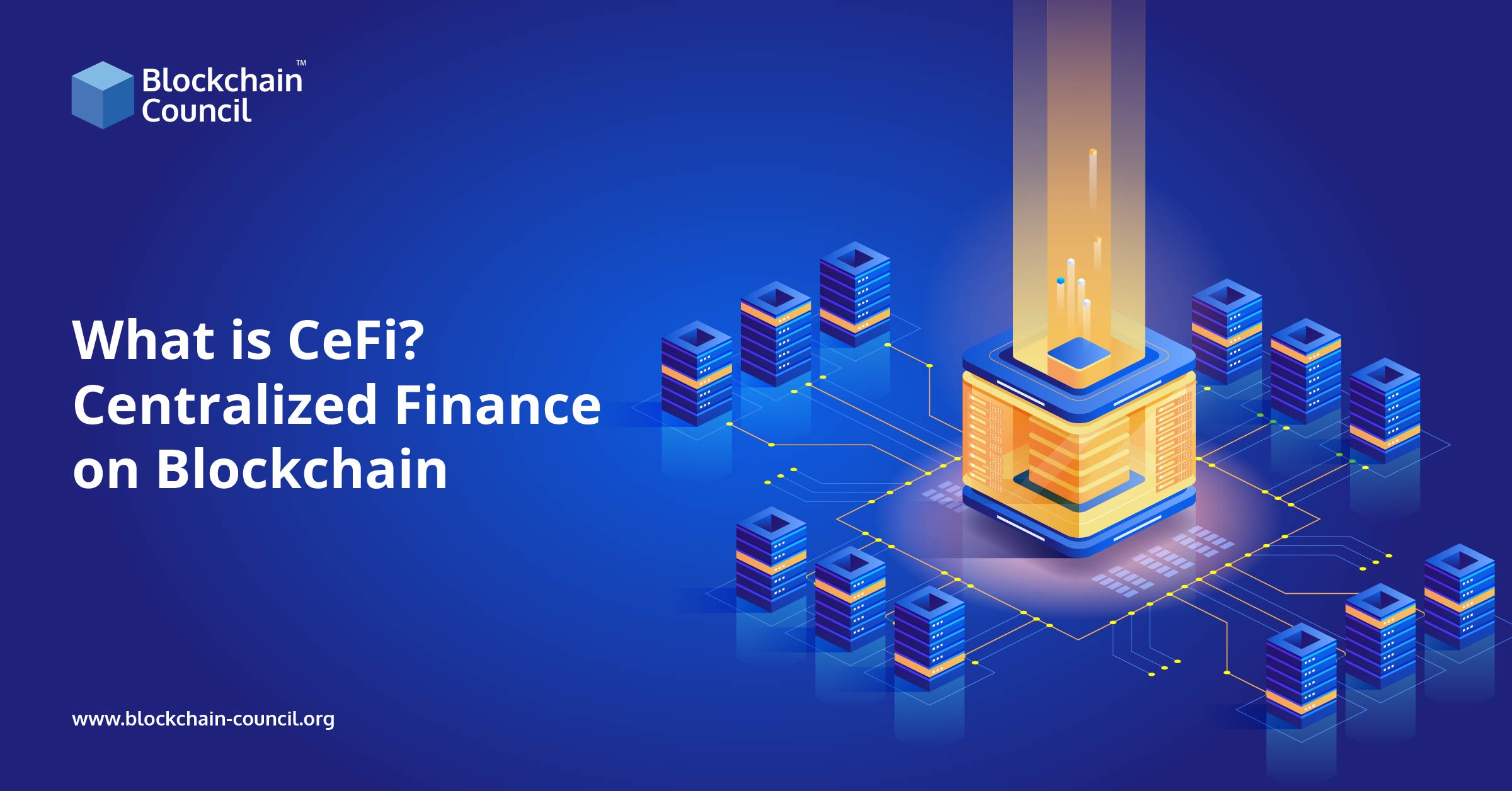
- Blockchain Council
- June 08, 2022

The financial world has discovered a new way of trading thanks to the growth of blockchain platforms and the advent of cryptocurrencies in the technological sphere. Although bitcoin was founded with the intention of decentralizing the financial trading system, it was solely utilized for cryptocurrency trading.
So, in addition to crypto trading, centralized and decentralized finance (DeFi) was created, which includes characteristics such as issuing crypto loans, trading crypto derivatives such as Bitcoin Futures, and tokenizing digital assets.
Centralized finance (CeFi) exchanges, which function as a middleman, control users’ crypto transactions and activity. We will discuss everything that you need to know to get started with CeFi, and how CeFi differs from DeFi.
What is CeFi (Centralized Finance)?
Centralized finance is a financial activity in which individuals can earn interest and obtain loans on their cryptocurrency via centralized exchanges. Private keys to your crypto assets would be transferred to your preferred third-party company in order to conduct your preferred payments and coin orders. CeFi’s goal is to optimize the performance and cost-efficiency of transactional services while ensuring fair exchanges.
According to blockchain experts, CeFi is one of the few revolutionizing technologies that combines some of the yield advantages of DeFi with the simplicity and reliability of typical financial-services products. CeFi allows you to earn savings interest, obtain funds, expend with a cryptocurrency debit card, and much more.
One of the important elements of cryptocurrency is “decentralization,” which enables exchanges between individuals anywhere around the globe to take place without the involvement of any intermediaries. DeFi (Decentralized Finance) expands the idea to a broader spectrum. It’s a full network of smart-contract-powered applications that help you to exchange, lend, save, etc., everything without the need for a bank or transaction controller.
However, because DeFi is a new technology, it comes with its own set of concerns. Navigating DeFi protocols necessitates a rather high degree of technical expertise as well as a willingness to risk losing some or all of your capital due to flawed code, malevolent actors, or even simple human failure.
While the main concept around CeFi is to establish cryptocurrency investment options that combine some of the return advantages of DeFi with the simplicity of use and security of regular investment instruments (sometimes called as TradFi). CeFi enables borrowing money, purchasing and selling cryptocurrency, spending and earning incentives using a cryptocurrency debit card, and much more.
Features of CeFi
Centralized Exchange (CEX)
Participants transfer payments to a standard cryptocurrency platform, such as Binance, Kraken, or Coinbase, to control them within an internal account. Though money is housed on the crypto exchange, they are maintained outside of individuals’ custody and are exposed to attacks if the exchange’s security protocols collapse.
Therefore, centralized exchange leads to the subject of a variation of security breaches. However, users on the centralized exchange do not mind disclosing private credentials or entrusting finances to these organizations because they believe central exchanges are credible and secure.
Additionally, major exchanges have completely different departments with consumer care services to help their users. The high level of consumer service convinces the user, maintaining the sense of knowing one’s assets are in trustworthy hands.
Higher Interest Rates
CeFi networks set their own interest rates, making them more stable because market pressures do not influence them. However, rates of interest are also substantially higher than on DeFi networks.
The Flexibility of Fiat Conversion
When changing money to cryptocurrency and vice versa, centralized institutions provide more adaptability than decentralized alternatives. Normally, exchanging cryptos for money requires the involvement of a centralized organization; however, DeFi solutions do not supply fiat in this manner. Therefore, onboarding consumers into the Centralized Finance (CeFi) platform is simple and can improve customer satisfaction.
Cross-chain services
CeFi facilities let you exchange LTC, XRP, BTC, as well as other self-governing blockchain-based currencies. Considering the time and difficulty of accomplishing cross-chain trades, DeFi facilities may not accept these currencies.
CeFi can avoid this problem by obtaining custody of cash from multiple chains. CeFi has a strong benefit over this since several of the most commonly traded and highest-market-cap coins are on distinct blockchain systems which do not adhere to interworking protocols.
Availability of Customer Service
Blockchain technology is a constantly evolving subject, and investors may find it difficult to keep up with the trend. To aid during periods of uncertainty, well-established institutions have competent customer support divisions. Furthermore, they prefer to provide simple access to huge information on cryptocurrency in order to educate their consumers. Hodlnaut Resources, for example, covers the whole DeFi ecosystem, from income accounts to loans and lending to cryptocurrency assistance.
Applications of CeFi
Some of the real-world applications of CeFi are:
- A centralized exchange like BlockFi is a borrowing and financing network for bitcoin and fiat currencies.
- Celsius is also a bitcoin lending, remittance, and trading platform for users to perform business.
- Fairlay is a cryptocurrency forecasting marketplace and exchange based on the CeFi idea.
- Ledn is considered as a Bitcoin borrowing and lending network for DAI.
- Libra is a global financial infrastructure platform with a virtual currency layer to trade on.
Some of the examples of a CeFi exchange are:
Binance
Binance, a cryptocurrency exchange that was created in 2017, has grown to be one of the most popular, with over 180 countries covered. It concentrates on altcoin trading, with over 500 different cryptocurrencies and virtual tokens to choose from, including Bitcoin (BTC), Ethereum (ETH), Dogecoin (DOGE), and its own Binance Coin (BNB).
Hodlnaut
Hodlnaut is a fintech firm established in Singapore that caters to individual investors and cryptocurrency enthusiasts. Hodlnaut, which was founded in April of this year, is swiftly becoming one of Asia’s most promising crypto lending platforms. Hodlnaut is on a mission to make it simple for hodl-ers to obtain greater yield on their digital assets with its simple product options and committed assistance.
Coinbase
Coinbase is the most popular bitcoin exchange, with over 56 million verified users. A wide range of goods is available, including a sophisticated trading platform and a wallet for regular investors. Coinbase is on a mission to use cryptocurrency to build a more equitable, accessible, efficient, and transparent financial system.
How do you earn yield with CeFi?
CeFi presents the possibility of generating income through crypto-based accounts that work similarly to typical bank savings accounts — but it may give significantly higher rates. Except for typical savings funds, crypto funds are not yet eligible for government-backed FDIC or SIPC coverage, so you must be conscious of the risks. Coinbase, on the other hand, provides a principle assurance on the USDC you invest for CeFi borrowing.
The overall idea is to keep a few of your cryptocurrencies on one of the many platforms that provide this sort of product. For example, users in various states in the United States can now consider signing up for a queue on Coinbase to begin generating an annual income of 4% for owning a USD Coin (USDC).
Where does the yield come from?
All or most of your cryptocurrency assets are placed to use and lent to anyone else. These lenders pay a rate of interest to the centralized source for financing, and that supplier pays a little of that amount to investors.
How does CeFi borrowing connect to CeFi lending/saving?
CeFi allows you to borrow money by countering your crypto holdings in a similar manner that you would use conventional assets as collateral for borrowed funds. It’s the inverse of lending: the interest consumers spend for borrowing funds is where it generates the income you may receive by keeping crypto through CeFi.
CeFi loans, in contrast to bank loans, often need minimal or no documentation. For example, residents in the United States may borrow up to $100,000 without the need for a credit check using Coinbase.
What are some CeFi risks?
- Each CeFi service and provider is distinctive, and your invested cryptocurrency may be used in ways with varying degrees of uncertainty. Therefore, it’s critical to conduct your research and knowledge about how your cryptocurrency is being used, how the return you’re getting is produced, and also what threats are involved.
- Because there are multiple intermediaries available in a Ce-fi, transaction fees unavoidably rise. This is one of the primary reasons why millions across the world are shifting toward a decentralized platform.
- The most significant issue is that centralized systems are always appealing to hackers. The latter intends to capitalize on the networks’ substantial liquidity. As an outcome, they use illicit computer technologies to breach the information, enabling them to steal money from customers.
- Users in CeFi give up ownership of their belongings to the exchangers. In these conversations, they also reveal personal details. If the transfer is breached or exposed to a cyberattack, there is a significant possibility of losing funds. Even if your funds are secure, there is still a chance that your confidentiality can be exposed.
- Keep in mind that crypto investments are not now eligible for the government-backed insurance that covers regular bank accounts. (However, Coinbase’s CeFi loan product range includes a primary assurance.)
- Certain CeFi operators may temporarily freeze your account. Coinbase, on the other hand, enables you to share your USDC at any time.
- Stable coins are not all made equal. USDC, for instance, is built on open-source technology that anybody can examine. The USDC is backed by dollar-denominated assets held within separate transactions with US-regulated investment firms, which are approximately equivalent in market price to the existing USDC. USDC can be purchased on platforms like Coinbase and stored in any Ethereum-compatible account. There are no expenses involved with converting US dollars to USDC. The USDC debut was made possible through a partnership among both Coinbase and Circle through the establishment of the CENTRE Consortium.
What do you mean by Decentralized Finance? (DeFi)
According to cryptocurrency experts, the decentralized exchange involves no transaction. The entire operation is controlled by automated programs built on blockchain networks. Decentralized financing also offers an equitable and accessible financial system in which anybody can engage. It makes use of a blockchain network to give unbanked people access to economic goods and services.
DeFi’s aim is to form an anonymous open-source platform, leading to a transparent economic services market. The decentralized banking industry provides lending, yield farming, crypto borrowing, asset holding, as well as other operations.
The benefit of DeFi versus CeFi is that users would have total power over one’s cash and possess the account’s shared key. Furthermore, individuals who want to engage in DeFi must access DeFi functions using decentralized applications (dApps) based on blockchain networks.
Difference between CeFi and DeFi
The following are the primary distinctions between centralized and decentralized financial services:
The primary distinction between the two systems is the mode of transaction. The system is governed by controlled money exchanges. Meanwhile, Decentralized finance is dependent on technology. Binance, Coinbase, Libra, and several prominent CeFi exchanges have long provided virtual currency operations. The DeFi marketplace is run on a blockchain network similar to Ethereum technology.
Therefore, with the exchanges’ participation in CeFi, people move their uncertainty to the transactions. It leads to exchanges being in charge of protecting consumers’ funds. In DeFi, these intermediaries are eliminated. The operations are based on the premise that smart contract mechanisms will work.
Centralized finance facilitates currency-to-crypto transactions and cross-chain alternatives. In the instance of an unfavorable incident, such as a hack, centralized finance can relocate funds to aid customers or prohibit trade if needed. Apart from this, DeFi is perceived as more accessible and non-intrusive since it does not need personal data from consumers and is non-custodial. However, CeFi can prohibit trade and put restrictions on consumers, but DeFi cannot do something like this.
Conclusion
CeFi ensures the security and fairness of such payments. Crypto trading is open to conventional money traders as well. Additionally, unlike DeFi services, CeFi exchanges provide customer assistance. CeFi leads to building trust along the journey. It ensures fund protection and good deals upon those assets.
Every approach has benefits and drawbacks. The investment and their needs reveal it. Therefore, after learning from this article, one must have a decent notion of which one is the right option for you.
If you think of pursuing a career in blockchain development, then you have landed at the right place. Blockchain Council is working according to the present crypto industry standards and is offering some of the best blockchain certification. You need to simply check the list of available blockchain technology courses on the website’s homepage and enroll in one.





































































 Guides
Guides News
News Blockchain
Blockchain Cryptocurrency
& Digital Assets
Cryptocurrency
& Digital Assets Web3
Web3 Metaverse & NFTs
Metaverse & NFTs
